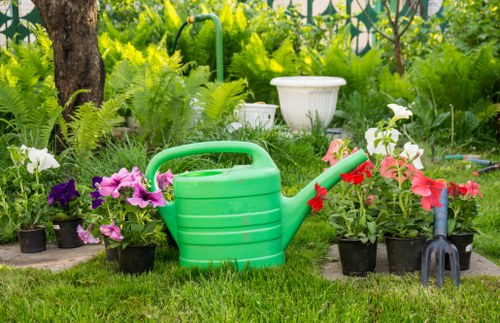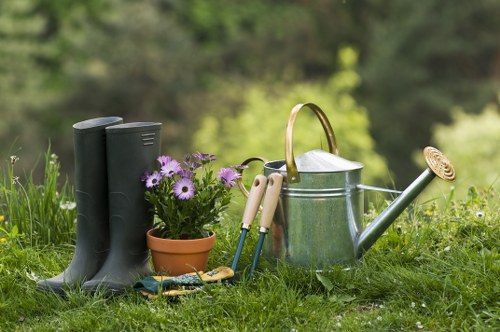Mastering Landscaping in Lawn Turf Installation
Introduction to Lawn Turf Installation

Landscaping plays a pivotal role in enhancing the aesthetic appeal and functionality of outdoor spaces. One of the most critical aspects of landscaping is lawn turf installation, which transforms barren areas into lush, green sanctuaries. Whether you're a homeowner looking to revamp your yard or a commercial property manager aiming to create an inviting environment, understanding the nuances of turf installation is essential.
The success of any turf installation project hinges on meticulous planning, quality materials, and professional execution. This comprehensive guide delves into the key components of landscaping in lawn turf installation, providing you with the knowledge to achieve a vibrant and enduring lawn.
From soil preparation to selecting the right turf variety, each step in the installation process contributes to the overall health and appearance of your lawn. Let's explore the intricacies of landscaping in lawn turf installation to help you create a stunning outdoor space.
Understanding the Importance of Soil Preparation

Soil preparation is the foundation of a successful lawn turf installation. Healthy soil ensures that the turf takes root effectively, providing the necessary nutrients and support for robust growth. Proper soil preparation involves several critical steps:
- Soil Testing: Conducting a soil test helps determine the pH levels and nutrient content, allowing for appropriate amendments.
- Clearing the Area: Removing existing vegetation, rocks, and debris creates a clean slate for turf installation.
- Grading and Leveling: Ensuring the ground is level prevents water accumulation and promotes even growth.
- Amending the Soil: Adding organic matter or fertilizers enhances soil fertility and structure.
Neglecting soil preparation can lead to poor turf establishment, increased susceptibility to diseases, and uneven growth. Investing time in this initial phase pays dividends in the longevity and beauty of your lawn.
Choosing the Right Turf Variety

Selecting the appropriate turf variety is crucial for aligning with your climate, soil type, and usage requirements. Different types of turf offer varying levels of durability, color, and maintenance needs. Some popular turf varieties include:
- Bermuda Grass: Ideal for warm climates, it thrives in full sun and is highly drought-resistant.
- Fescue: Suited for cooler climates, it offers a lush, dark green appearance and tolerates shade well.
- Zoysia Grass: Known for its density and ability to withstand heavy foot traffic, making it perfect for high-use areas.
- St. Augustine: Prefers moist, shady environments and provides a thick, carpet-like texture.
Consulting with a landscaping professional can help you determine the best turf variety for your specific needs, ensuring a thriving and attractive lawn.
Installation Techniques for Optimal Growth

Proper installation techniques are vital for the successful establishment of turf. Here are key practices to follow:
- Timing: Installing turf during the appropriate season, typically in spring or early fall, ensures optimal growing conditions.
- Laying the Turf: Place turf rolls tightly together without overlapping or leaving gaps to prevent weed growth.
- Rolling and Pressing: Gently rolling the turf after installation helps ensure good soil contact and reduces air pockets.
- Watering: Initial watering should be thorough, followed by regular irrigation to keep the soil moist until the turf establishes.
Adhering to these techniques promotes strong root development, uniform growth, and a resilient lawn capable of withstanding environmental stresses.
Maintenance Tips for a Healthy Lawn

Consistent maintenance is essential to sustain the beauty and health of your lawn. Implementing a regular care regimen includes:
- Mowing: Keep the grass at the recommended height for its type to encourage thick growth and prevent weeds.
- Fertilizing: Apply appropriate fertilizers based on soil test results to replenish nutrients.
- Weed Control: Use herbicides or manual removal methods to manage unwanted vegetation.
- Aeration: Periodically aerate the soil to improve air, water, and nutrient penetration.
- Pest Management: Monitor for pests and diseases, addressing issues promptly to prevent widespread damage.
Proper maintenance not only enhances the visual appeal of your lawn but also extends its lifespan, ensuring a vibrant and inviting outdoor space year-round.
Enhancing Your Lawn with Landscaping Features
Integrating landscaping features with your lawn turf installation elevates the overall design and functionality of your outdoor area. Consider incorporating elements such as:
- Pathways: Create inviting walkways using materials like stone, gravel, or pavers to guide visitors through your landscape.
- Garden Beds: Add colorful flower beds or shrubs to provide contrast and visual interest.
- Water Features: Install fountains, ponds, or waterfalls to introduce soothing sounds and attract wildlife.
- Lighting: Use outdoor lighting to highlight focal points and enhance safety during evening hours.
- Seating Areas: Designate spaces for relaxation with benches, pergolas, or outdoor furniture.
These landscaping additions complement your lawn, creating a cohesive and harmonious outdoor environment that caters to both aesthetics and practicality.
Benefits of Professional Turf Installation
Opting for professional turf installation services offers numerous advantages:
- Expertise: Professionals bring specialized knowledge and experience, ensuring proper installation and long-term success.
- Quality Materials: Access to high-quality turf varieties and installation materials enhances the durability and appearance of your lawn.
- Time Efficiency: Professionals can complete the installation process swiftly and efficiently, minimizing disruption.
- Customized Solutions: Tailored recommendations and services cater to your specific landscaping needs and preferences.
- Warranty and Support: Many professional services offer warranties and ongoing support, providing peace of mind.
Investing in professional turf installation ensures a well-executed project, resulting in a lush and resilient lawn that adds value and beauty to your property.
Cost Considerations and Budgeting
Understanding the financial aspects of lawn turf installation helps in effective budgeting and decision-making. Key cost factors include:
- Scope of the Project: The size of the area and the complexity of the landscape design influence overall costs.
- Turf Variety: Premium turf types may incur higher expenses but offer superior quality and longevity.
- Soil Preparation: Comprehensive soil testing and amendment can affect the total budget.
- Labor Costs: Professional installation fees vary based on location and service providers.
- Additional Features: Incorporating landscaping elements like pathways, lighting, and water features will add to the overall cost.
Creating a detailed budget that accounts for these factors ensures that your turf installation project remains financially manageable while achieving the desired outcome.
Sustainable Landscaping Practices
Embracing sustainable practices in lawn turf installation contributes to environmental conservation and reduces maintenance efforts. Consider the following eco-friendly strategies:
- Water-Efficient Turf: Choose drought-resistant turf varieties to minimize water usage.
- Composting: Utilize composted organic matter to enrich the soil naturally.
- Integrated Pest Management: Employ natural pest control methods to reduce chemical reliance.
- Native Plants: Incorporate native flora that thrives in local conditions, reducing the need for extensive maintenance.
- Energy-Efficient Irrigation: Install smart irrigation systems that optimize water distribution and usage.
Adopting sustainable landscaping practices not only benefits the environment but also enhances the resilience and health of your lawn, ensuring it remains vibrant for years to come.
Common Challenges in Lawn Turf Installation
While lawn turf installation offers numerous benefits, it also presents potential challenges that require careful consideration:
- Poor Soil Quality: Inadequate soil can impede turf establishment and growth, necessitating extensive preparation.
- Climate Variability: Extreme weather conditions can affect turf survival and health.
- Pest Infestations: Pests and diseases can compromise turf integrity if not managed promptly.
- Improper Installation: Errors during installation, such as incorrect turf laying or inadequate watering, can lead to poor outcomes.
- Maintenance Negligence: Inconsistent care practices can diminish the lawn's appearance and longevity.
Acknowledging these challenges and implementing proactive measures ensures that your lawn turf installation project overcomes obstacles, resulting in a thriving and beautiful lawn.
Future Trends in Lawn Turf Installation
The landscape industry continually evolves, introducing innovative trends that enhance lawn turf installation practices:
- Artificial Intelligence: AI-driven tools assist in landscape design and turf selection, offering personalized recommendations.
- Eco-Friendly Materials: Sustainable materials and practices gain popularity, aligning with environmental consciousness.
- Smart Irrigation Systems: Advanced irrigation technologies optimize water usage and reduce waste.
- Low-Maintenance Turf: Development of turf varieties that require minimal upkeep caters to busy lifestyles.
- Integrated Landscaping: Seamless integration of turf with other landscape elements creates cohesive and functional outdoor spaces.
Staying informed about these trends allows homeowners and landscapers to adopt cutting-edge techniques, ensuring that lawn turf installation remains efficient, sustainable, and aesthetically pleasing.
Conclusion: Achieving the Perfect Lawn
Landscaping in lawn turf installation is a multifaceted process that demands attention to detail, quality materials, and ongoing maintenance. By understanding the critical components—from soil preparation and turf selection to installation techniques and sustainable practices—you can cultivate a lush, resilient lawn that enhances your property's beauty and value.
Whether undertaking the project yourself or enlisting professional services, prioritizing each step ensures a successful outcome. Embrace the art and science of lawn turf installation to transform your outdoor space into a vibrant, inviting oasis.
Ready to transform your lawn? Contact us today to book your turf installation service and take the first step towards a beautiful, green landscape.